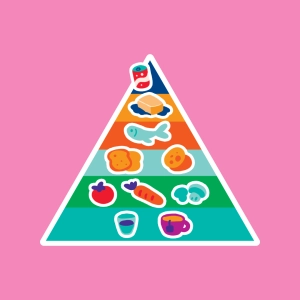 Food Pyramid
Food Pyramid
Learning objectives
- To know how to identify the major food families and their nutritional content.
- To know how to put together a balanced meal.
- To have a critical look at one’s own diet.
In our current societies, dietary matters also involve questions of the environment, of public health, of culture and of education. Balanced meals are essential to guaranteeing the proper functioning of our organism, but our current lifestyles do not always allow us to meet that goal. As a result, numerous illnesses (cardiovascular problems, diabetes) have, abnormally, become increasingly common. However, certain dietary regimes (Mediterranean) protect against these bad statistics. Is there one or many ways to eat well? What rules should we establish? What food references should we follow in order to maintain good health? The nutritionists pose such questions.
The food pyramid is one possible answer. It provides an educational back-up that makes us aware of the quantity and the nature of the foods we must consume every day.
It classifies all foods into large families according to their nutritional and energy providing values. The base of the pyramid contains foods that can be consumed in large quantities, the summit contains the rich foods that, if consumed in excess, unbalance a meal. No food is forbidden. Only the quantity and the frequency of consumption are important.
This animation as a tool that enables a student to identify the nature of the foods he or she consumes. It aims to be an object of reflection for the children so as to enable them to determine whether or not their dietary regime corresponds to the recommendations made by nutritionists.

Discover EduMedia for free
The interactive encyclopedia that brings science and math to life in the classroom.
Over 1,000 resources



